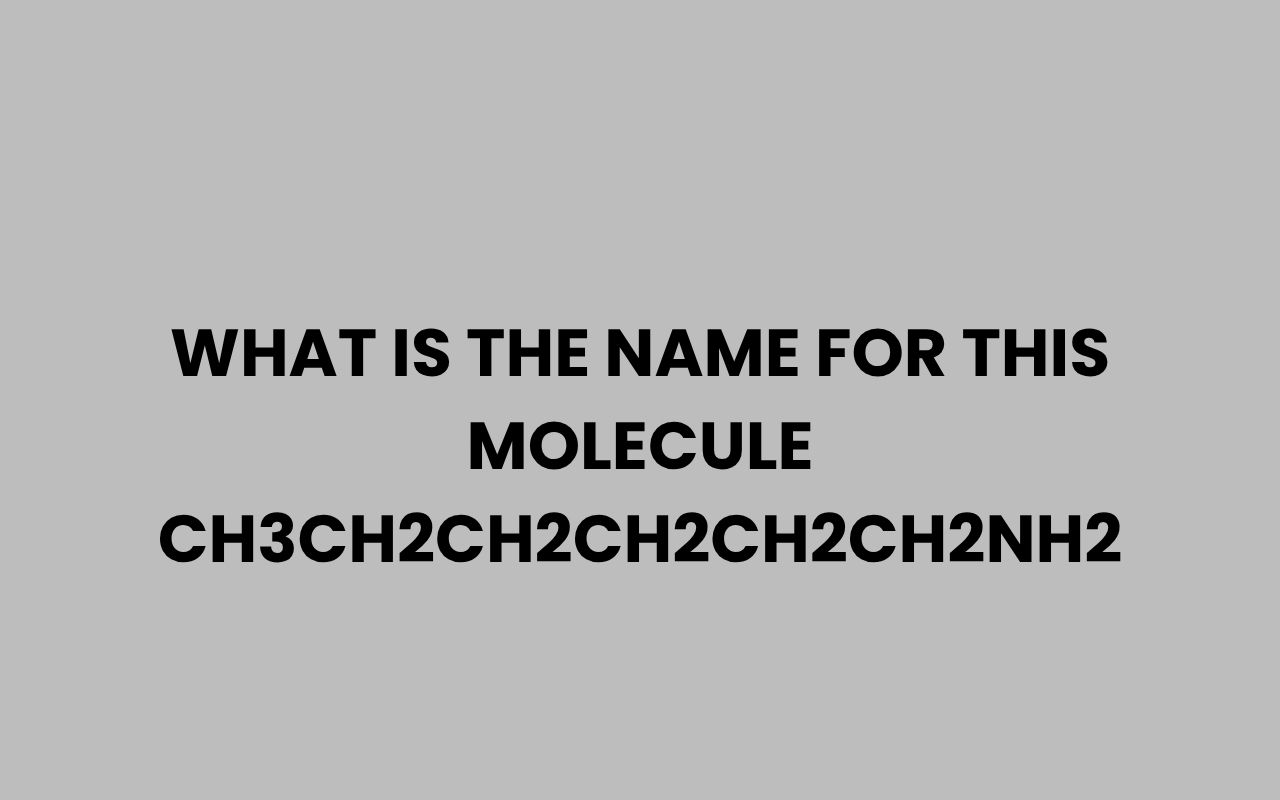The molecular formula CH3CH2CH2CH2CH2CH2NH2 represents a six-carbon chain with an amino group attached at one end. Understanding the systematic naming of organic molecules like this is fundamental in organic chemistry.
This article explores the chemical structure, nomenclature, properties, and significance of this molecule. Detailed explanations and comparative data will help clarify exactly what this compound is called and why.
Breaking Down the Molecular Formula
The formula can be read as:
- CH3: a methyl group at the start of the chain
- CH2 repeated five times: a continuous chain of methylene groups
- NH2: an amino functional group attached at the terminal carbon
The molecule is an amine with a straight six-carbon alkyl chain and a primary amine group (–NH2) at the end.
Structural Formula Representation
Visually, the molecule looks like this:
CH3–CH2–CH2–CH2–CH2–CH2–NH2
This linear arrangement identifies the molecule as an aliphatic primary amine derived from hexane.
Systematic Name of the Molecule
According to IUPAC (International Union of Pure and Applied Chemistry) nomenclature rules, the molecule is named based on the longest carbon chain and the presence of the functional group.
Since there are six carbons and an amino group attached to the first carbon, the molecule is named 1-hexanamine. Alternatively, it is often called hexylamine in common usage.
| Aspect | Description |
|---|---|
| Parent Alkane | Hexane (6 carbons) |
| Functional Group | Primary amine (–NH2) |
| Position of Amino Group | Carbon 1 (terminal end) |
| IUPAC Name | 1-Hexanamine |
| Common Name | Hexylamine |
Explanation of the Naming Convention
The IUPAC system prioritizes the longest carbon chain as the parent hydrocarbon. The suffix -amine is added to indicate the presence of an amino group.
Numbering starts from the end nearest to the functional group to give the substituent the lowest possible number. Since the amino group is attached to carbon 1, it is named accordingly as 1-hexanamine.
“The naming of amines follows the pattern of naming the parent alkane and suffixing with ‘-amine’, while the position number designates the carbon atom bonded to the amino group.” – IUPAC Nomenclature Guidelines
Chemical Properties of 1-Hexanamine
As a primary amine, 1-hexanamine exhibits specific chemical properties that are influenced by its alkyl chain and the amino group.
- Basicity: The amino group can accept a proton, making the molecule basic.
- Reactivity: It can participate in nucleophilic substitution and condensation reactions.
- Solubility: Moderately soluble in water due to hydrogen bonding by the amine group, but less soluble than shorter-chain amines because of the longer hydrophobic carbon chain.
Physical Properties
| Property | Value | Notes |
|---|---|---|
| Molecular Formula | C6H15N | |
| Molar Mass | 101.19 g/mol | Calculated from atomic masses |
| Appearance | Colorless liquid | Typical of primary alkyl amines |
| Boiling Point | ~ 171 °C | Higher than hexane due to hydrogen bonding |
| Density | 0.82 g/cm³ (approx.) | Less dense than water |
| Odor | Amine-like, fishy smell | Characteristic of many low molecular weight amines |
Applications and Uses of 1-Hexanamine
1-Hexanamine is an important intermediate in organic synthesis. Its primary amine group makes it a versatile building block for various chemical processes.
Some common applications include:
- Pharmaceutical industry: Used in the synthesis of certain drugs and active pharmaceutical ingredients (APIs).
- Agrochemicals: Serves as a precursor for herbicides and insecticides.
- Rubber industry: Acts as a curing agent or additive.
- Solvent and corrosion inhibitor: In some specialized formulations.
Reactivity in Chemical Synthesis
The amine group in 1-hexanamine participates in various reactions such as acylation, alkylation, and condensation. It can form amides, imines, and Schiff bases, which are crucial in creating more complex molecules.
“The versatility of 1-hexanamine as a nucleophile enables its use as a key intermediate in the synthesis of pharmaceuticals, dyes, and polymers.” – Organic Chemistry Texts
Comparison with Other Alkyl Amines
To better understand 1-hexanamine, it is useful to compare it with shorter and longer alkyl amines.
| Molecule | Formula | IUPAC Name | Boiling Point (°C) | Common Uses |
|---|---|---|---|---|
| CH3NH2 | CH3NH2 | Methylamine | -6.3 | Pharmaceuticals, polymers |
| CH3CH2NH2 | C2H7N | Ethylamine | 16.6 | Agrochemicals, solvents |
| CH3(CH2)4NH2 | C5H13N | 1-Pentanamine | 131 | Intermediate chemicals |
| CH3(CH2)5NH2 | C6H15N | 1-Hexanamine | 171 | Pharmaceuticals, agrochemicals |
| CH3(CH2)6NH2 | C7H17N | 1-Heptanamine | 194 | Specialty chemicals |
This comparison shows how increasing carbon chain length affects boiling point and solubility, while maintaining similar chemical reactivity due to the amino group.
Safety and Handling
1-Hexanamine, like many alkyl amines, requires careful handling due to its chemical nature.
- Toxicity: It can be irritating to skin, eyes, and respiratory tract.
- Flammability: It is flammable and should be kept away from ignition sources.
- Storage: Store in a cool, well-ventilated area inside tightly sealed containers.
Proper personal protective equipment (PPE), such as gloves and goggles, is recommended when working with this compound.
“The safety datasheet for 1-hexanamine highlights the need for ventilation and protective measures to avoid inhalation and skin contact due to its irritant properties.” – Chemical Safety Guidelines
Summary
CH3CH2CH2CH2CH2CH2NH2 is a six-carbon primary amine known as 1-hexanamine or hexylamine. It consists of a straight alkyl chain and a terminal amino group.
This molecule is important in organic chemistry due to its basicity, reactivity, and use as an intermediate in manufacturing pharmaceuticals, agrochemicals, and specialty chemicals.
Understanding its structure and properties provides insight into the behavior of primary amines and how chain length influences physical characteristics.

